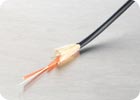The Cost of Optical Fiber

A well-designed optical cabling infrastructure minimizes the lifecycle cost by providing the greatest degree of flexibility.
Think of it as lifecycle cost.
Cost of the total security system infrastructure over time is critical when evaluating infrastructure choices. This framework looks beyond the installation to what is coming down the road. Will the current infrastructure accommodate emerging technology trends, institutional growth or down-sizing, changes in types of threats, shifts in subject behavior, legislative requirements or basic surveillance location changes?
Simply put, can the solution quickly and easily keep up with the necessary moves, adds and changes while minimizing costs? What is the incremental infrastructure material and installation cost associated with addressing these potential needs?
A well-designed optical cabling infrastructure minimizes this lifecycle cost by providing the greatest degree of flexibility. The bandwidth and distance afforded by optical cable will ensure that either the addition of applications or the advancement of existing technologies can be accommodated. Copper cable types have advanced every couple of years to keep up with emerging technology trends. A standard single-mode fiber installed 20 years ago in a campus environment has the capability to handle even the most cutting-edge electronic security and commercial IT technologies available today. This is an amazing feat given the well-documented technology explosion of the 1990s.

SCALABLE AND FLEXIBLE
The physical size of a multi-fiber optical cable will ensure critical pathways and spaces are not consumed by single-task over-sized cables, thus enabling future cable additions. The scalable optical pre-terminated solutions now offered by cabling manufacturers also address this flexibility. The ability to engineer optical drop points along a single cable run illustrates a truly unique new level of flexibility. Now chief security officers and their IT colleagues have the ability to simply tap into a dark port built directly into the cable itself. This functionality enables almost immediate connectivity to a wide array of devices. The speed and quality of this type of connectivity solution is unmatched by any competitive alternative.
Fiber optics cables are suited for electronic security applications. And the construction of the cable adds to reliability.
COST OF MANAGEMENT AND MAINTENANCE
The days of the static cable plant for security applications are probably going the way of the VCR for security tapes. New technologies, including IP convergence, will likely require access to the same cabling plant by a greater number of people. IT and facilities, IT and security, or all of the above, will now require access.The ability for a larger group of people to organize, manage and maintain a shared infrastructure now becomes more challenging and more critical. While the cost of managing a cabling plant is often overlooked, it is critical to understand that this represents a real cost and a major drain on resources when issues arise. Problem diagnosis and repair become more complicated and time consuming with poor management practices. Unintentional disruption to other key services is a concern during problem resolution in unorganized, non-structured systems.
Optical cabling infrastructure hardware components have long been designed with efficient management as a primary engineering focus. This need for organization is an essential requirement in the high quality of service world of telephony and cable television. It is also an absolute essential in security video design and the IT data center. These are areas where fiber is extremely prevalent and the need for density and management is considered essential. Fiber optic hardware, unlike its competitors, continues to get smaller and more manageable. It enables effective connectivity, labeling and patching options, while simultaneously minimizing precious real estate in wiring closets or telecom rooms. Coaxial cables continue to be bulky and difficult to manage. Higher-data-rate UTP cables are also growing in size and management complexity as high-data-rate cables become more prominent.
COMPONENT COST COMPARISON
Component cost is not the best measure of total value when doing a comparison of alternatives. This may, however, be the only comparison performed, so it is important to consider. Bulk copper prices have increased. As such, copper UTP and coaxial cable manufacturers forced to deal with this reality have increased cable prices. Conversely, optical fiber has seen multiple price reductions over the last few years. The fiber termination process has become easier, creating an increased number of competent installers driving more competitive installation rates.The cable cost, termination cost, testing cost and connectivity cost are all increasing as high-data-rate copper cables become more complex. This is especially important for those considering a long-term migration plan to integrate network cameras.
Fiber transceiver manufacturers face increasing competition, which is having a downward impact on electronic prices. An increasing number of international vendors, as well as some of the giants of the IT equipment world, are entering into the fiber transmission space. This market relative to security applications has long been dominated by only a few companies. This increased competition is driving media converter and fiber transceiver pricing down while driving up customer options and technological advancements.
SUMMARY
This is arguably the most dynamic period in the history of security. The flexibility and capability associated with optical fiber will provide a future-proofed system that will reduce the total life cycle cost. Now is a great time to learn from the historically dynamic information technology industry. Security operations that have chosen not to use fiber have had to absorb the cost, on multiple occasions, of upgrading their cabling solution as critical technologies outpaced their legacy plants capabilities.The inherent performance advantages of optical fiber are well understood, and have been for a long time. Minimizing the two major objections of price and ease of installation has been a standing objective of optical cable and connectivity manufacturers. Over the last ten to 15 years, these objections have steadily turned into advantages for optical fiber. The new reality of a cost-effective, easy-to-install optical cabling solution should make optical fiber a clear choice when designing a security cabling infrastructure. You can now have a premium cabling solution that fully maximizes the capabilities of all the advanced security technologies coming onto the market.
Optical fiber should no longer be relegated to an afterthought. Look at the advantages of fiber.
SIDEBAR: Busting the Myths
Two myths are still active in the industry, even among experienced professionals: Myth One – Fiber is extremely difficult to install, terminate and test. Myth Two – A fiber solution is too expensive. The February 2007 article demystifies both.When one thinks of fiber optic cable, there may be visions, maybe even nightmares, of goopy, messy, flooded cables with fragile, hair-sized, needle-like strands of sharp glass. Terminating those sticky strands once included the painstaking process of meticulously cleaning the fibers to install a fan-out kit, followed by mixing and curing epoxies.
There are simply too many unique variables in play to make definitive blanket statements regarding the cost of one solution over another. Therefore, when attempting to dispel these myths, simply acquire information and a framework for comparison so that the end-user, integrator or design engineer can compare processes instead of being intimidated by an old myth.
Looking for a reprint of this article?
From high-res PDFs to custom plaques, order your copy today!


